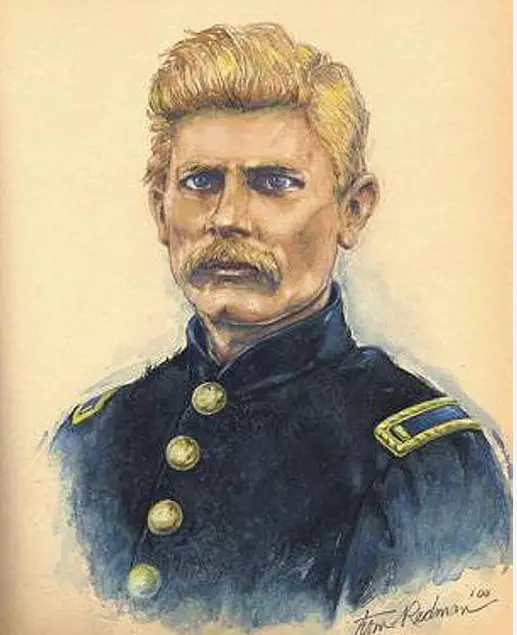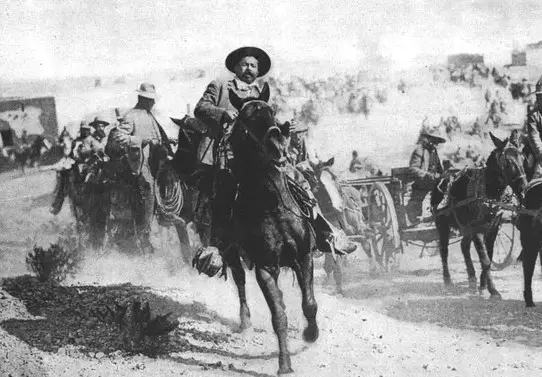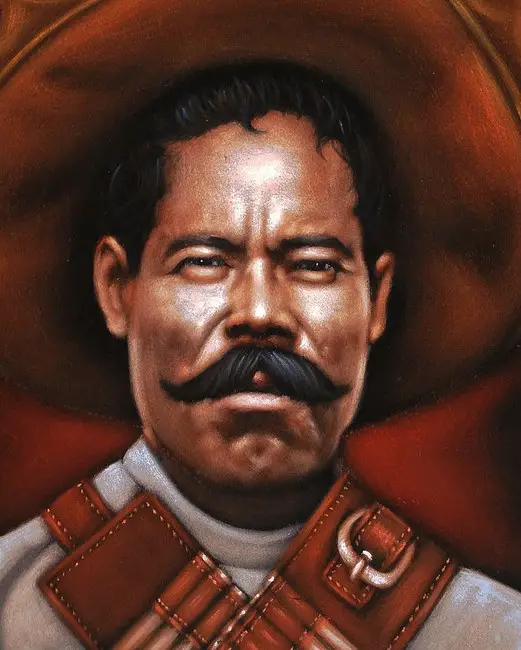Podcast: Play in new window | Download
Subscribe: Apple Podcasts | RSS
 In October of 1913, 71-year-old Ambrose Bierce left Washington DC to tour some old Civil War battle sites. At the time, Bierce – who was a veteran of 20 Civil War battles – was one of the most respected and controversial journalists in America. He was also a poet and short-story writer whose bizarre tales garnered the praise of authors from Stephen Crane to H.P. Lovecraft. Bierce did not stop at the last southern battlefield during his tour. He decided to cross Texas and go into Mexico as the Mexican Revolution was just getting started. The American author joined up with Pancho Villa as an observer and was there to witness Villa’s victory at the Battle of Tierra Blanca, 35 miles south of Ciudad Juarez. This was an important and impressive triumph for Villa. His 5,500 rebel troops defeated 7,000 federal soldiers loyal to the government of Victoriano Huerta. Villa lost 300 men to the Mexican government’s 1,000 men, and the so-called Army of the North captured 4 locomotives, 7 machine guns, hundreds of thousands of rounds of ammunition and over a hundred horses along with assorted supplies and other equipment. Ambrose Bierce wrote home about this battle, but soon after his correspondence stopped. In a letter to his niece Lora, the famous journalist wrote, “Goodbye. If you hear of my being stood up against a Mexican stone wall and shot to rags, please know that I think that a pretty good way to depart this life. It beats old age, disease, or falling down the cellar stairs. To be a gringo in Mexico—ah, that is euthanasia.” By the beginning of 1914, after traveling with Villa’s men to take the City of Chihuahua, Ambrose Bierce seemingly fell off the face of the earth. No one saw or heard from him again. So, what happened to this famous American writer?
In October of 1913, 71-year-old Ambrose Bierce left Washington DC to tour some old Civil War battle sites. At the time, Bierce – who was a veteran of 20 Civil War battles – was one of the most respected and controversial journalists in America. He was also a poet and short-story writer whose bizarre tales garnered the praise of authors from Stephen Crane to H.P. Lovecraft. Bierce did not stop at the last southern battlefield during his tour. He decided to cross Texas and go into Mexico as the Mexican Revolution was just getting started. The American author joined up with Pancho Villa as an observer and was there to witness Villa’s victory at the Battle of Tierra Blanca, 35 miles south of Ciudad Juarez. This was an important and impressive triumph for Villa. His 5,500 rebel troops defeated 7,000 federal soldiers loyal to the government of Victoriano Huerta. Villa lost 300 men to the Mexican government’s 1,000 men, and the so-called Army of the North captured 4 locomotives, 7 machine guns, hundreds of thousands of rounds of ammunition and over a hundred horses along with assorted supplies and other equipment. Ambrose Bierce wrote home about this battle, but soon after his correspondence stopped. In a letter to his niece Lora, the famous journalist wrote, “Goodbye. If you hear of my being stood up against a Mexican stone wall and shot to rags, please know that I think that a pretty good way to depart this life. It beats old age, disease, or falling down the cellar stairs. To be a gringo in Mexico—ah, that is euthanasia.” By the beginning of 1914, after traveling with Villa’s men to take the City of Chihuahua, Ambrose Bierce seemingly fell off the face of the earth. No one saw or heard from him again. So, what happened to this famous American writer?
Let’s go back to the beginning and visit the early life of this famous “disappeared” person. Ambrose Gwinnet Bierce was born in a log cabin in Ohio on June 24, 1842. One of thirteen children, Bierce moved with his family to Indiana when he was a boy. Although his family had meager means, they were very literate and young Ambrose was surrounded by books from an early age. At the age of 15 he began his journalism career. Bierce left home to work as an apprentice at an abolitionist newspaper called The Northern Indianan. He was 18 at the start of the American Civil War and in 1861 Bierce enlisted in Union Army’s 9th Indiana Infantry. He fought in the first land engagement of the war at the Battle of Philippi in western Virginia on June 3, 1861. From there he participated in 19 more battles and campaigns, including the Battle of Shiloh and the Burning of Atlanta. This extensive Civil War experience would influence his desire later in life to go to Mexico and be caught up in the action once again. Bierce seemed destined to go through officers training at West Point, but because of a traumatic brain injury suffered at the Battle of Kennesaw Mountain, Bierce had to table a serious future military career and was discharged from the Army in January of 1865. A year and a half later, Ambrose Bierce rejoined the Army and accompanied General William Babcock Hazen on an expedition to inspect military outposts across the Great Plains, starting from Omaha, Nebraska. At the end of 1866 Bierce found himself in San Francisco, California, where a new life for him began.
 In California he rekindled his interest in journalism and wrote for such publications as The San Francisco News Letter, The Argonaut, The Overland Monthly, The Wasp and The Californian. Bierce would move to England in 1872 and live there for a few years before returning to San Francisco. While in England he continued his writing career. On his return to the States in 1875 he picked up where he left off in the California newspaper scene, taking a brief break to be a manager of a failed mining operation in the Dakota Territory from 1879 to 1880. He eventually became editor of The Wasp and moved on to become one of the first columnists and editors at William Randolph Heart’s San Francisco Examiner. By the 1890s Ambrose Bierce was considered to be one of the most influential journalists in America. In January of 1896, Hearst sent Bierce to Washington DC to try to foil the Railroad Refinance Bill which was making its way through Congress. The bill would have forgiven government loans made to the Union Pacific and Central Pacific railroads to the tune of $130 million. Bierce wrote about this railroad bill exhaustively and generated enough public outcry through his writings that the bill failed in Congress. This incident, and other controversial writings, caused Bierce to have many enemies in very high places. Besides lampooning politicians and captains of industry in the press and exposing corruption of government and business, Ambrose Bierce also had a very illustrious literary career. He published dozens of books, over 550 short stories and 846 fables, ranging from horror to fantasy to historical fiction.
In California he rekindled his interest in journalism and wrote for such publications as The San Francisco News Letter, The Argonaut, The Overland Monthly, The Wasp and The Californian. Bierce would move to England in 1872 and live there for a few years before returning to San Francisco. While in England he continued his writing career. On his return to the States in 1875 he picked up where he left off in the California newspaper scene, taking a brief break to be a manager of a failed mining operation in the Dakota Territory from 1879 to 1880. He eventually became editor of The Wasp and moved on to become one of the first columnists and editors at William Randolph Heart’s San Francisco Examiner. By the 1890s Ambrose Bierce was considered to be one of the most influential journalists in America. In January of 1896, Hearst sent Bierce to Washington DC to try to foil the Railroad Refinance Bill which was making its way through Congress. The bill would have forgiven government loans made to the Union Pacific and Central Pacific railroads to the tune of $130 million. Bierce wrote about this railroad bill exhaustively and generated enough public outcry through his writings that the bill failed in Congress. This incident, and other controversial writings, caused Bierce to have many enemies in very high places. Besides lampooning politicians and captains of industry in the press and exposing corruption of government and business, Ambrose Bierce also had a very illustrious literary career. He published dozens of books, over 550 short stories and 846 fables, ranging from horror to fantasy to historical fiction.
In October of 1913 when Ambrose Bierce left his home in DC with his ultimate destination being Mexico, he was still on top of his game, although maybe a little bored with the routine of life at age 71. As previously mentioned, he was eager to witness a new war brewing south of the border and rode alongside famous Mexican revolutionary Pancho Villa as an observer. Bierce sent letters home for a few months until they abruptly stopped in January of 1914. Because Ambrose Bierce was such a high-profile individual, US consular officials investigated his disappearance, using a German national named Felix A. Sommerfeld to spearhead the probe. Sommerfeld supplied Pancho Villa with arms from the United States and worked to get Villa’s legal recognition as the legitimate ruler of Mexico among American politicians. Sommerfeld’s report stated that Ambrose Bierce was last seen somewhere in Chihuahua in January 1914 with no other details.
To this day, no one knows what really happened to one of America’s most treasured and controversial journalists, but there are many theories about the disappearance of Ambrose Bierce based on some evidence and wild speculation.
 The first theory claims that Bierce was shot by firing squad on orders of Pancho Villa himself for reasons that are unclear. The execution supposedly took place in the small desert town of Sierra Mojada in the Mexican state of Coahuila. This theory was proposed by a retired American priest who heard stories from old-timers living in the town about how a famous American journalist was shot by Pancho Villa and buried in an unmarked grave in a local cemetery. Reasons for the assassination are numerous and are speculative. Was Bierce accused of being a spy? Was there a woman involved? In any event, the American priest saw fit to put a tombstone on that unmarked grave which reads: “Very trustworthy witnesses suppose that here lie the remains of Ambrose Gwinnett Bierce 1842 – 1914 a famous American writer and journalist who on suspicion of being a spy was executed and buried at this place.” No one has exhumed the remains for further study, so no one really knows if the famous writer really does rest in the Sierra Mojada Cemetery.
The first theory claims that Bierce was shot by firing squad on orders of Pancho Villa himself for reasons that are unclear. The execution supposedly took place in the small desert town of Sierra Mojada in the Mexican state of Coahuila. This theory was proposed by a retired American priest who heard stories from old-timers living in the town about how a famous American journalist was shot by Pancho Villa and buried in an unmarked grave in a local cemetery. Reasons for the assassination are numerous and are speculative. Was Bierce accused of being a spy? Was there a woman involved? In any event, the American priest saw fit to put a tombstone on that unmarked grave which reads: “Very trustworthy witnesses suppose that here lie the remains of Ambrose Gwinnett Bierce 1842 – 1914 a famous American writer and journalist who on suspicion of being a spy was executed and buried at this place.” No one has exhumed the remains for further study, so no one really knows if the famous writer really does rest in the Sierra Mojada Cemetery.
The second theory of the disappearance of Ambrose Bierce involves suicide. According to this theory, Bierce was distraught over losing two of his children, so instead of heading to Mexico to ride with Pancho Villa, he went to the Grand Canyon where he killed himself in a secret place. This theory supposes that Bierce was suicidal, which was most likely not the case, as his children died years before and there would be no need to go so far away from Washington DC to kill himself. In his last letter home to a niece, Bierce wrote, “As to me, I leave here tomorrow for an unknown destination.” The proponents of the suicide theory often cite this line as revealing his plan to end it all, while others see it as being very literal, as Pancho Villa did much traveling throughout the northern part of Mexico and wasn’t following a set itinerary most of the time.
The third theory involves Bierce’s old political and business rivals wanting to get even. Under the cover of the Mexican Revolution, influential people whom Bierce either mocked or exposed years before had him killed. No physical evidence at all supports this theory but it would be a convenient way to get rid of a controversial writer who was still writing very powerful editorials well into his 70s. If Bierce had been allowed to return to the US, what would he have said about America’s future involvement in World War One just a few years away? Perhaps someone or a group of people from the American side of the border saw to it that Bierce’s voice was forever silenced.
 The fourth theory states that Ambrose Bierce was killed by Mexican federales before he even met up with Pancho Villa. An American mercenary named Tex O’Reilly claimed in his autobiography that an American was arrested by Mexican federal forces in a noisy cantina in the town of Sierra Mojada and was accused of being a spy. Because this American could not speak Spanish to defend himself, he was dragged to the local cemetery and was shot, later being buried there in an unmarked grave. After the shooting, Tex O’Reilly was taken to the room where this unknown gringo was staying, and O’Reilly asked if there was anything that the mysterious American left behind. According to O’Reilly’s book, “The old fellow reached up behind a rafter on the wall and brought out two old empty envelopes left by the Americano, and they were both addressed to Ambrose Bierce.”
The fourth theory states that Ambrose Bierce was killed by Mexican federales before he even met up with Pancho Villa. An American mercenary named Tex O’Reilly claimed in his autobiography that an American was arrested by Mexican federal forces in a noisy cantina in the town of Sierra Mojada and was accused of being a spy. Because this American could not speak Spanish to defend himself, he was dragged to the local cemetery and was shot, later being buried there in an unmarked grave. After the shooting, Tex O’Reilly was taken to the room where this unknown gringo was staying, and O’Reilly asked if there was anything that the mysterious American left behind. According to O’Reilly’s book, “The old fellow reached up behind a rafter on the wall and brought out two old empty envelopes left by the Americano, and they were both addressed to Ambrose Bierce.”
A fifth theory claimed that Ambrose Bierce rode with Pancho Villa and valiantly survived the battles of the Mexican Revolution only to die on the American side of the border from pneumonia. A good summation of this theory comes from an article by Chris Opfer on the “How Stuff Works” website. The author states:
“Journalist Jake Silverstein in 2002 explored the theory that Bierce bid adieu to the physical world in Texas, not Mexico. Silverstein dug up an old letter to the editor of a tiny local newspaper in Marfa, Texas, from a man who claimed Bierce’s body was buried there in an unmarked grave. That man told Silverstein that he had once picked up a hitchhiker who had fought for the Mexican federal forces as a teenager. The hitchhiker told the story of picking up an old gringo who appeared quite sick and called himself ‘Ambrosia.’ He paid the man and his friends to help get him back into the U.S. and during the trip he talked of the many books he had written, one with the word ‘devil’ in the title. But ‘Ambrosia’ didn’t survive the trip back to the U.S., and instead died of pneumonia on January 17, 1914, his body buried in an unmarked grave in Marfa, Texas. It’s possible that the man who called himself ‘Ambrosia’ was Ambrose Bierce.”
So, how did one of America’s most esteemed writers meet his end? Was it at the hands of a disgruntled railroad executive? Was he mistaken as a spy and shot by the Mexican government? Or was he executed by Pancho Villa himself? We may never have answers to this enduring mystery.
REFERENCES
Charles River Editors. Ambrose Bierce: The Life and Mysterious Disappearance of the Famous American Author. CreateSpace: 2016. We are Amazon associates. To purchase the book, go here: https://amzn.to/3mdLysx
Various online sources
